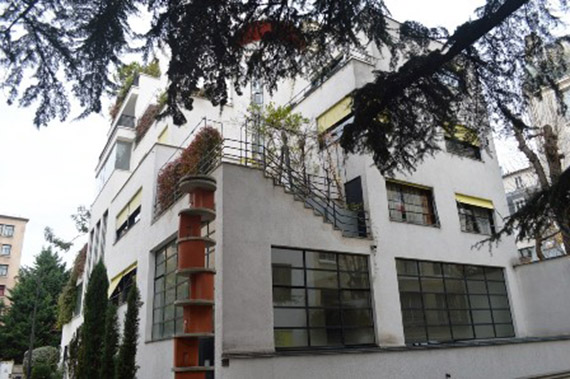Rue Mallet-Stevens
In one of the most fashionable districts of Paris, in the 16th arrondissement, not far from the picturesque Avenue Mozart, there is a small, dead-end street that exudes the atmosphere of refined charm of the interwar Parisian artistic elite. It is called Rue Mallet-Stevens and there is no street in the world that bears its name with more justification. Namely, Robert Mallet-Stevens was the architect who designed all the buildings in that street, he himself lived there, and the owners and tenants of the other buildings were his personal friends and like-minded artists. The street was named that way immediately after its formation, at the initiative of the tenants, and with that act, the then forty-year-old architect was given an unusual honor. Robert Mallet-Stevens was the most respected and influential architect in France at that time.
Well, if that’s the case, how come we haven’t heard of him before now. Who was he really and what happened to him?
Parisian artistic elite
Robert Mallet-Stevens was born in 1886 into a wealthy Parisian bourgeois family where he was exposed to artistic stimuli from an early age. Both his father and his grandfather were art collectors, in Paris and Brussels, and the house in which he was born was designed by the most famous French Baroque architect Francois Mansart, after whom the characteristic Parisian attics got their name. He was educated at the Ecole Speciale d Architecture, an elite school that was less conservative than the rival École des Beaux-Arts, and where he nevertheless came into contact with newer artistic trends, which later had a decisive influence on his career. Such a development did not have to wait long. The Great War of 1914 cast doubt on the entire previous civilization and the art world was dominated by new, revolutionary, often intolerant, poorly understood artistic trends. Cubism, Dadaism, Fauvism, Futurism, Surrealism and Constructivism, something new every day, but it suited Mallet-Stevens perfectly and he found himself among the pioneers of new art. He was particularly fascinated by film, to which he contributed both as a publisher of a film magazine and as a designer for some of the most avant-garde surrealist films.
Soon, however, it became clear that the mainstream in design and architecture was leading to a moderate, optimistic direction that would later be known as Art Deco. This could be considered a flirtation with the past that Mallet-Stevens could not endure forever, so he founded the Union de Artistes Moderne with a group of dissidents, of which he was the president. They published a proclamation in which it is written: “We must stand up against everything that looks rich, against everything that is well made, against everything that we inherited from our grandmothers…”
What a fierce, fundamental, cultural and civilizational turn? What kind of people were they who sound more destructive than the notorious punks of the 1970s? Did they, according to their proclamation, have long beards, did they wear black coats with corpses’ heads, and wear the torn trousers of American farmers?
Oh no… it was just the opposite. Mallet-Stevens was the embodiment of the bourgeois dandy and arbiter elegantiae of his time. Demanding but gallant, he was a favorite customer of elegant Parisian tailors. From the finest lister trousers to silk shirts and ties, everything about him looked rich, well-made and completely in keeping with the notions he had picked up from his grandmother, from a childhood spent in a house full of classical European art. It should be borne in mind that Mallet-Stevens and his like-minded members were members of the highest class of Parisian artistic circles, the crème de la crème, and in that world verbal rebelliousness was valued as très chic. One of the occasional followers of the Mallet-Stevens art association went a step further. He was a talented, overbearing architect who gave himself a sonorous name, Le Corbusier, in order to be more recognizable. Similar in many ways to Mallet-Stevens, Le Corbusier would develop his own version of architectural modernism and personal marketing, and thus Mallet-Stevens finally got a real rival for the status of the most respected French architect.
Classy street for the new age
At the peak of his architectural career, Mallet-Stevens got a unique chance to design all the buildings in a newly planned street in Paris and thus, in reality, embody his artistic ideas. The owners of those facilities were all his friends and had complete trust in him. Thus, in the period 1926-1929, six buildings emerged that make up a unique ambient unit of the purest modernism, so uncharacteristic for the city that we associate it with buildings of a completely different type.

Each object is different, but they share some common characteristics. The construction is made of reinforced concrete, and it can be seen that the architect is enjoying the won freedom brought by that material. Large spans, many windows in a row, lots of air. In the geometrical sense, it is about clean flat surfaces, visually dynamically arranged cubes and only in some places, the occasional rounded surface to, as a spice, contribute to a reduced, minimalist aesthetic. It is the same with the use of colors. All the walls are completely white, and the blinds and a few other rare, purely geometric details are yellow, bordered by a dark lock, which all together gives a suprematist impression. Such an unobtrusive approach to architecture allowed the greenery, both on the street and on the numerous terraces, to be a natural counterbalance to the strict geometry of the buildings and an equal factor in defining the ambience.
The owner of the land on which the street was later built was the banker Daniel Dreyfuss, and one of the built buildings remained in his ownership (Rue Mallet-Stevens 7).
The house at 3-5 Rue Mallet-Stevens was bought by the ballet choreographer Eric Moise Allatini and his wife Helena, a writer. Eric was born in Thessaloniki, where his family was among the richest, and I wrote about the Thessaloniki Villa Allatini, the former property of that family, which is an important cultural and historical monument there, elsewhere.
The house with house number 8 in Rue Mallet-Stevens was bought by the pianist Mme Reifenberg, and the owners of the most architecturally appreciated villa on the street, at house number 10, were twins Joel and Jean Martel, cubist sculptors, and themselves among the founders of the Union de Artistes Moderne art association. Their studio was on the ground floor, and living quarters on the upper floors. It was similar in house no. 12 where Mallet-Stevens lived with his family. The last, sixth house in the street, also architecturally interesting, was for the caretaker who took care of the maintenance of all those buildings.

It was a dream street, made as an example to show what kind of life is expected in the twentieth century, the age of functionality, health and development. Peace, quiet, greenery, central heating, a telephone in every room, and the neighbors are all intellectuals – artists themselves. When the facilities were completed and ceremonially put into use, it was the event of the day in Paris, which was recorded by all the newspapers and film news cameras, so for the next few months, visitors to French cinemas had the opportunity to watch the idyll from the upper social classes on the big screens and indulge fantasies about your future.
Out of step with the real world
It’s all fine and dandy, but at that time, architecture had already taken a different path. In the American cities, New York and Chicago, a new aesthetic was formed, based on technical superiority, and Le Corbusier and other European theoreticians presented their increasingly concrete architectural philosophies to the professional public. Avant-garde artistic experiments, until yesterday in the center of attention, were definitely losing their importance.
Robert Mallet-Stevens, the crème de la crème, a rich bourgeois dandy who played with the post-war extreme avant-garde, did not do well in the new circumstances and in the following years lived more on old glory than on new ideas. The street where he lived and which bore his name, itself slowly sank into oblivion. Of course, people still loved Parisian architecture, but even then, as now, primarily the classic Haussmannian boulevards and art nouveau buildings, which his architecture, of course, did not fit into.
Unfortunately, instead of eternal peace and progress, the world entered a new war. During the German occupation of Paris, Mallet-Stevens, whose wife was racially threatened, quickly moved to the south, to Vichy France, where they were still safer, and when he returned, immediately after the liberation of Paris, he could only state it will never be the city where he spent his whole life. Like the first world war, the second one also left deep wounds. But, while the catastrophe of the first war gave rise to a whole series of avant-garde artistic movements, the second one only reinforced nothingness and ideological numbness. The street with his name is a symbolic embodiment of that numbness. Although the buildings in the street bearing his name remained intact, the artistic atmosphere that gave it its unsurpassed charm was irretrievably destroyed. His dear neighbors, Allatini and Dreyfussi were killed in Auschwitz, and we can only guess about Mrs. Reifenberger’s fate. Disillusioned with the world he naively tried to fix, Robert Mallet-Stevens died in Paris on February 8, 1945, while the war was still going on, before he could participate in the post-war reconstruction, for which he no longer had enthusiasm anyway. His last wish was to have his entire archive burned, which was done lightly, without any discussion, immediately.
This definitely resolved the outcome of the old rivalry with Le Corbusier. Having in the previous period unsuccessfully offered his services to both the Soviet communist authorities and the Vichy government, the patient Le Corbusier waited for his moment and became the hero of the post-war construction boom and a leading name in world architecture, an outcome that only emphasizes the contrast with his practically forgotten colleague Mallet -Stevens.
As part of a broader program, Mallet-Stevens Street was placed under protection in 1975, when only the Martel brothers’ building remained in its original form and has been maintained in an exemplary manner since then, giving passers-by the opportunity to immerse themselves, at least for a short time, in a specific the atmosphere of futile interwar optimism.



